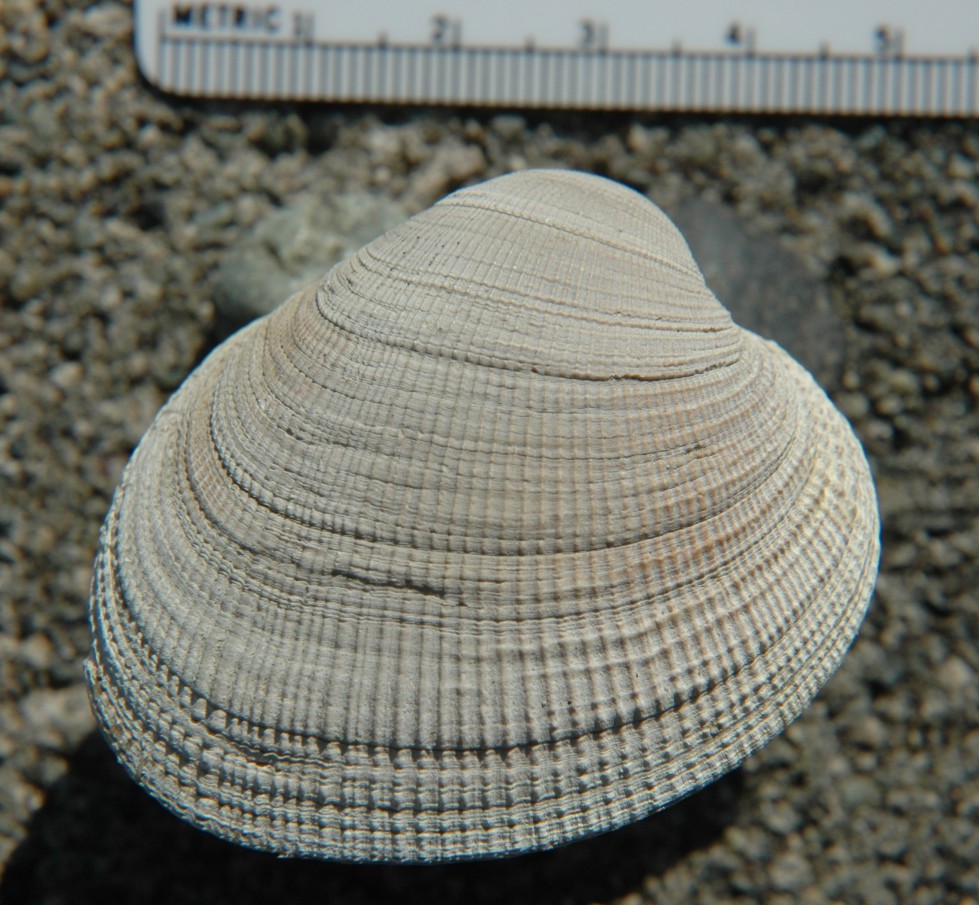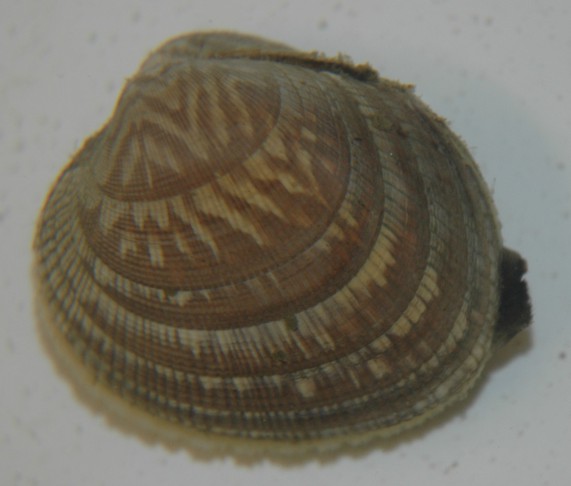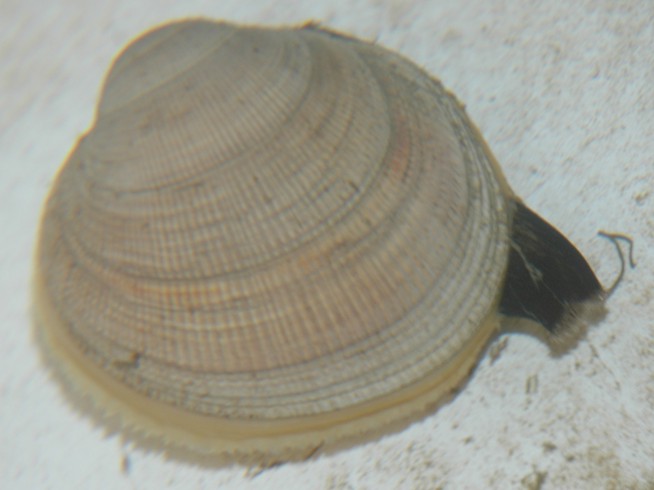Leukoma staminea (Conrad, 1857)Common name(s): Littleneck clam, Common Pacific littleneck, rock cockle, hardshell clam, Tomales Bay cockle, rock clam, ribbed carpet shell |
|
| Synonyms: Paphia staminea, Venerupis staminea, Protothaca staminea, Protothaca restorationensis |  |
| Phylum Mollusca
Class Bivalvia Subclass Heterodonta Order Veneroida Family Veneridae |
|
| Leukoma staminea. | |
| (Photo by: Dave Cowles, July 2007) | |
How to Distinguish from
Similar Species:
Look especially for the fine teeth on the inside ventral
margin of the shell. Venerupis
philippinarum, the Manila clam or Japanese
Littleneck, is longer
than it is high and its radial
ribs are usually more prominent than in this
species. Its siphons
are not fused all the way to the tips, and the ventral
margin of the shell has no fine teeth. Saxidomus
gigantea, the butter clam, has only concentric
sculpture and the
shell gapes slightly at the posterior end. Protothaca
tenerrima
is uncommon in protected bays and in sandy mud. Its hinge
ligament is nearly half the shell length and it grows as
large as 8
cm. The cockle Clinocardium
nuttallii is a similar shape and has similar color
patterns but
it has strongly serrated ventral
margins to the shell and the radial
ribs are much stronger than in P. staminea.
Note: Mercenaria
mercenaria,
an Atlantic species, looks and keys very similarly to Leukoma
staminea
and is also commonly sold in supermarkets. They even have the
fine
serrations on the inside of the ventral margin of the valves.
These
Mercenaria
can be distinguished from Leukoma by the fact that Mercenaria
usually has few radial ridges on the outside of the shell while Leukoma
typically has well-developed ones.
Geographical Range: Aleutian Islands, Alaska to southern Baja California
Depth Range: Lower half of the intertidal down to 10 m depth
Habitat: In stable sand, packed mud, or gravel-clay mixtures in protected areas, usually buried less than 8 cm below the sediment. Sometimes found in gravelly sediments among rocks on the open coast. Occasionally found in empty burrowing clam holes subtidally on the outer coast; in that situation they have raised, concentric lamellae on their shell.
Biology/Natural History: This common clam is not a true cockle but is sometimes called a rock cockle because it is similarly shaped and has (fainter) radial ribs like some cockles (see Clinocardium nuttallii). It is often harvested and sold for food, though it is is susceptible to paralytic shellfish poisoning. Often contains larval tapeworms in large numbers (which cannot infect humans but do infect the bat stingray). In quiet places such as Hood Canal it often grows so abundantly that shells are nearly touching one another. The species cannot dig fast so is not found in unstable sand. Predators include oyster drill snails such as the leafy hornmouth snail Ceratostoma foliatum and moon snails such as Euspira lewisii, Octopus such as Enteroctopus dofleini, sea otter, and the crabs Metacarcinus magister and Cancer productus. Pacific staghorn sculpins nip the extended siphons. Spawns during the summer in British Columbia and Alaska, and grows slowly (to only 2.5 cm in 2nd year, or even more slowly in Alaska). May hybridize with other species such as P. tenerrima and Venerupes philippinarum. The annual growth lines in the shell are distinct. May live 8-16 years.
Dudas
et al. (2005) found that the common local cancer crabs Metacarcinus
magister (Dungeness crab) and Cancer
productus (red rock crab) preferred the
thin-shelled introduced
varnish clam Nuttallia
obscurata to the thicker-shelled clams Leukoma
staminea
and Venerupis
philippinarum
if access to all was equally easy. However, Nuttallia
obscurata typically lives deeper in the sediment
than do Leukoma
staminea or Venerupis philippinarum.
If they had to dig for them, Metacarcinus
magister still ate more Nuttallia
obscurata than it did of the other clam species,
but C.
productus' preference switched to Leukoma
staminea and Venerupis
philippinarum.
| Return to: | |||
| Main Page | Alphabetic Index | Systematic Index | Glossary |
References:
Dichotomous Keys: (most key the species as Protothaca staminea)Allen, 1976
Carlton, 2007
Fitch 1953
Flora and Fairbanks, 1966
Kozloff 1987, 1996
Smith and Carlton, 1975
General References:
Brusca
and Brusca, 1978
Harbo,
1997
Harbo,
1999
Hinton,
1987
Johnson
and Snook, 1955 (as Paphia staminea)
Kozloff,
1993
McConnaughey
and McConnaughey, 1985
Morris,
1966
Morris
et al., 1980
Niesen,
1994
O'Clair
and O'Clair, 1998
Ricketts
et al., 1985
Sept,
1999
Snyderman,
1988
Scientific Articles:
Dudas,
Sarah E., Iain J. McGaw, and John F. Dower, 2005.
Selective crab
predation on native and introduced bivalves in British
Columbia.
Journal of Experimental Marine Biology and Ecology 325:1 pp 8-17
Web sites:
Washington
Dept of Fish and Wildlife clam page
General Notes and Observations: Locations, abundances, unusual behaviors:
 |
 |
| Leukoma staminea has short siphons which are fused all the way to the end. The tips are black. The dark wispy material accumulating near the excurrent siphon in the individual to the right is pseudofeces. | |
Authors and Editors of Page:
Dave Cowles (2007): Created original page